Business Metrics Report: Analysis of Tesco's Performance and Strategy
VerifiedAdded on 2022/12/30
|18
|3005
|27
Report
AI Summary
This report provides a detailed analysis of Tesco's business performance using various metrics. It begins with an introduction to Tesco, highlighting its global presence and market position. The report then delves into the application of Business Metrics, specifically focusing on Key Performance Indicators (KPIs) and their benefits. A case study overview, based on Tesco's vision, mission, and values, is presented, emphasizing the use of KPIs for evaluation. The report examines financial indicators, performance measurement, and the importance of timely analysis. It explores how Tesco measures its business strategy, HR performance, and makes investment decisions. The report also covers collecting customer information, CRM processes, and the use of ERP systems. Finally, it discusses sales and customer metrics, providing a comprehensive view of Tesco's business operations and performance evaluation methods. The document is a student's work submitted to Desklib to help other students.
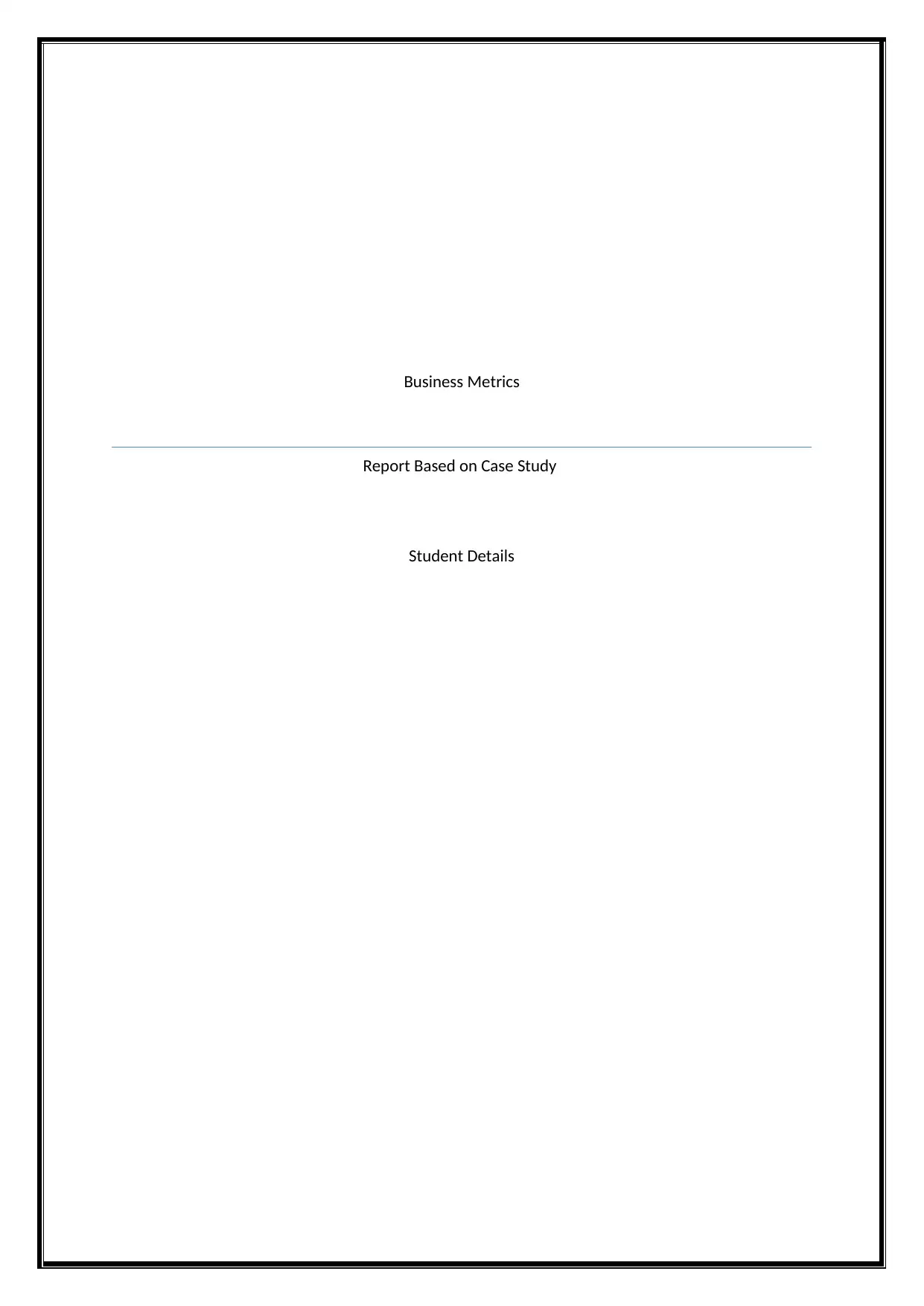
Business Metrics
Report Based on Case Study
Student Details
Report Based on Case Study
Student Details
Paraphrase This Document
Need a fresh take? Get an instant paraphrase of this document with our AI Paraphraser
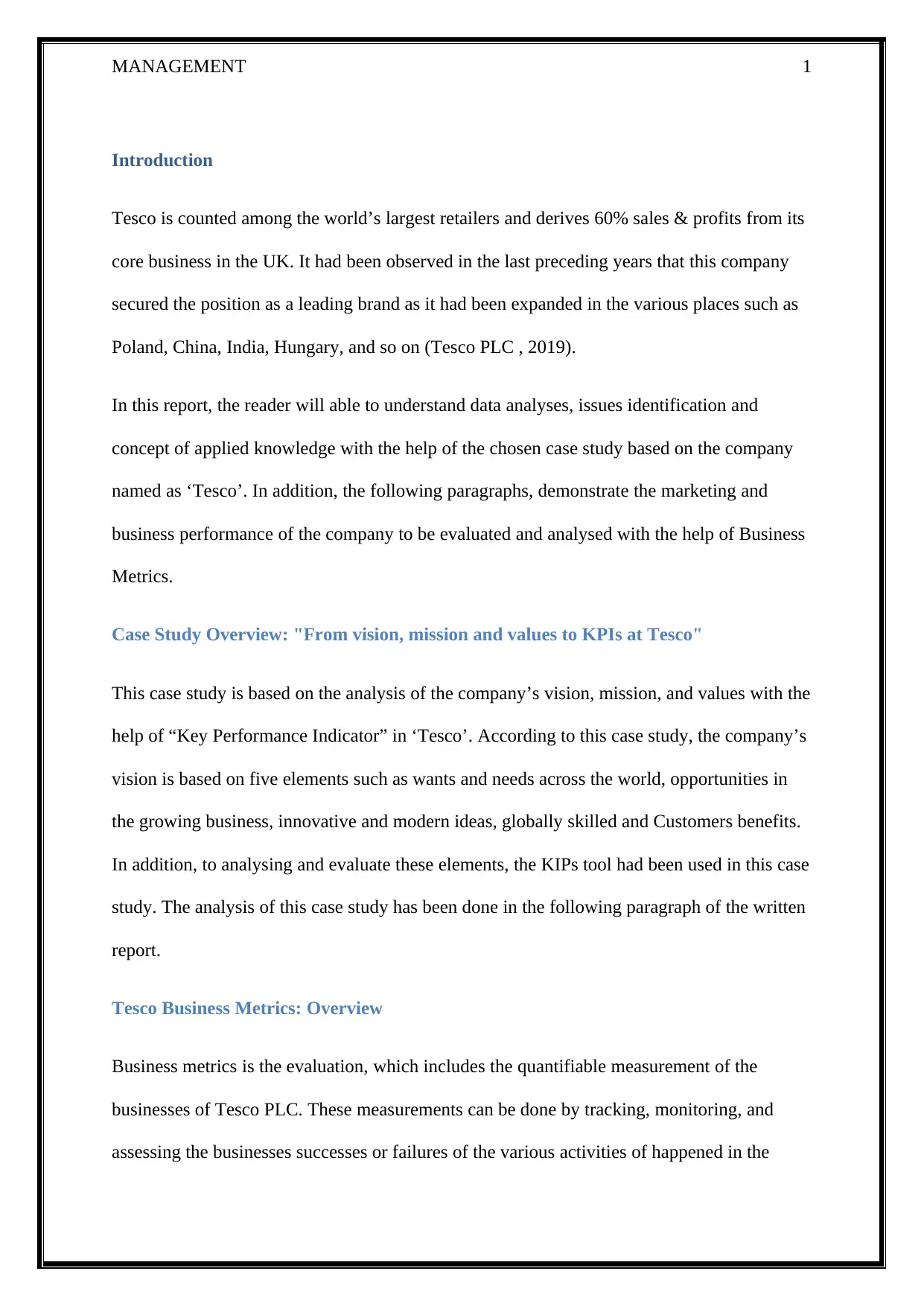
MANAGEMENT 1
Introduction
Tesco is counted among the world’s largest retailers and derives 60% sales & profits from its
core business in the UK. It had been observed in the last preceding years that this company
secured the position as a leading brand as it had been expanded in the various places such as
Poland, China, India, Hungary, and so on (Tesco PLC , 2019).
In this report, the reader will able to understand data analyses, issues identification and
concept of applied knowledge with the help of the chosen case study based on the company
named as ‘Tesco’. In addition, the following paragraphs, demonstrate the marketing and
business performance of the company to be evaluated and analysed with the help of Business
Metrics.
Case Study Overview: "From vision, mission and values to KPIs at Tesco"
This case study is based on the analysis of the company’s vision, mission, and values with the
help of “Key Performance Indicator” in ‘Tesco’. According to this case study, the company’s
vision is based on five elements such as wants and needs across the world, opportunities in
the growing business, innovative and modern ideas, globally skilled and Customers benefits.
In addition, to analysing and evaluate these elements, the KIPs tool had been used in this case
study. The analysis of this case study has been done in the following paragraph of the written
report.
Tesco Business Metrics: Overview
Business metrics is the evaluation, which includes the quantifiable measurement of the
businesses of Tesco PLC. These measurements can be done by tracking, monitoring, and
assessing the businesses successes or failures of the various activities of happened in the
Introduction
Tesco is counted among the world’s largest retailers and derives 60% sales & profits from its
core business in the UK. It had been observed in the last preceding years that this company
secured the position as a leading brand as it had been expanded in the various places such as
Poland, China, India, Hungary, and so on (Tesco PLC , 2019).
In this report, the reader will able to understand data analyses, issues identification and
concept of applied knowledge with the help of the chosen case study based on the company
named as ‘Tesco’. In addition, the following paragraphs, demonstrate the marketing and
business performance of the company to be evaluated and analysed with the help of Business
Metrics.
Case Study Overview: "From vision, mission and values to KPIs at Tesco"
This case study is based on the analysis of the company’s vision, mission, and values with the
help of “Key Performance Indicator” in ‘Tesco’. According to this case study, the company’s
vision is based on five elements such as wants and needs across the world, opportunities in
the growing business, innovative and modern ideas, globally skilled and Customers benefits.
In addition, to analysing and evaluate these elements, the KIPs tool had been used in this case
study. The analysis of this case study has been done in the following paragraph of the written
report.
Tesco Business Metrics: Overview
Business metrics is the evaluation, which includes the quantifiable measurement of the
businesses of Tesco PLC. These measurements can be done by tracking, monitoring, and
assessing the businesses successes or failures of the various activities of happened in the
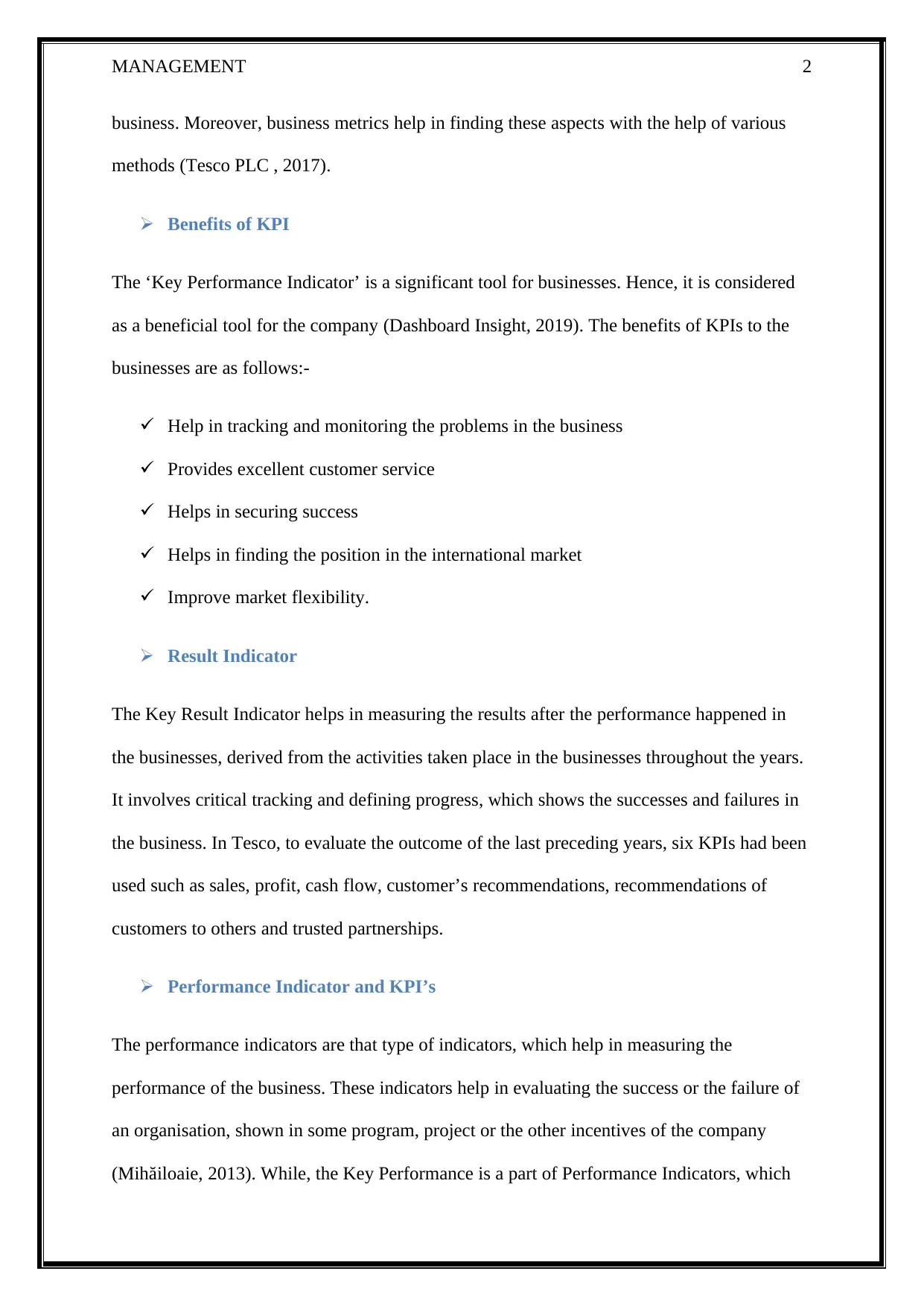
MANAGEMENT 2
business. Moreover, business metrics help in finding these aspects with the help of various
methods (Tesco PLC , 2017).
Benefits of KPI
The ‘Key Performance Indicator’ is a significant tool for businesses. Hence, it is considered
as a beneficial tool for the company (Dashboard Insight, 2019). The benefits of KPIs to the
businesses are as follows:-
Help in tracking and monitoring the problems in the business
Provides excellent customer service
Helps in securing success
Helps in finding the position in the international market
Improve market flexibility.
Result Indicator
The Key Result Indicator helps in measuring the results after the performance happened in
the businesses, derived from the activities taken place in the businesses throughout the years.
It involves critical tracking and defining progress, which shows the successes and failures in
the business. In Tesco, to evaluate the outcome of the last preceding years, six KPIs had been
used such as sales, profit, cash flow, customer’s recommendations, recommendations of
customers to others and trusted partnerships.
Performance Indicator and KPI’s
The performance indicators are that type of indicators, which help in measuring the
performance of the business. These indicators help in evaluating the success or the failure of
an organisation, shown in some program, project or the other incentives of the company
(Mihăiloaie, 2013). While, the Key Performance is a part of Performance Indicators, which
business. Moreover, business metrics help in finding these aspects with the help of various
methods (Tesco PLC , 2017).
Benefits of KPI
The ‘Key Performance Indicator’ is a significant tool for businesses. Hence, it is considered
as a beneficial tool for the company (Dashboard Insight, 2019). The benefits of KPIs to the
businesses are as follows:-
Help in tracking and monitoring the problems in the business
Provides excellent customer service
Helps in securing success
Helps in finding the position in the international market
Improve market flexibility.
Result Indicator
The Key Result Indicator helps in measuring the results after the performance happened in
the businesses, derived from the activities taken place in the businesses throughout the years.
It involves critical tracking and defining progress, which shows the successes and failures in
the business. In Tesco, to evaluate the outcome of the last preceding years, six KPIs had been
used such as sales, profit, cash flow, customer’s recommendations, recommendations of
customers to others and trusted partnerships.
Performance Indicator and KPI’s
The performance indicators are that type of indicators, which help in measuring the
performance of the business. These indicators help in evaluating the success or the failure of
an organisation, shown in some program, project or the other incentives of the company
(Mihăiloaie, 2013). While, the Key Performance is a part of Performance Indicators, which
⊘ This is a preview!⊘
Do you want full access?
Subscribe today to unlock all pages.

Trusted by 1+ million students worldwide

MANAGEMENT 3
includes the measurement of quality of work, workforce efficiency, productivity, profits, and
growth of the business (Swaine, 2015).
KPI Overview
Leading vs. Lagging Indicator
In the leading indicator, the typical input orientations are included that are hard to measure
and easy to improve or influence. While on the other hand, in the lagging indicators, the
typical output orientations are included that are easy to measure and hard to influence or
improve (Forbes , 2019).
The aim of measuring the business performance with the help of the indicators is to identify
and understand the ways to upgrade the performance of the business and both types of
indicators are required in the business, to have an improvement in the business. For example,
in Tesco, if the company wants to appoint the best talent for the position HR, then the
company can use lagging indicator and if this company wants to evaluate the whole growth
of the business then the Tesco must use the leading indicator for this purpose.
Financial Indicator
The key performance indicators showing the financial position of the business are the
financial indicators. There are various types of financial indicators such as Operating cash
flow, Working Capital, Current Ratio, Debt to Equity ratio, Revenue vs. targets, Expenses vs.
budget, Accounts payable turnover, Accounts receivable turnover, Inventory turnover, Return
on equity, quick ratio, and customer satisfaction (Gerber, 2019).
In Tesco PLC, the financial ratios are workings as the financial indicators of the company
helps in measuring the financial position of the company such as Total Shareholder Return,
includes the measurement of quality of work, workforce efficiency, productivity, profits, and
growth of the business (Swaine, 2015).
KPI Overview
Leading vs. Lagging Indicator
In the leading indicator, the typical input orientations are included that are hard to measure
and easy to improve or influence. While on the other hand, in the lagging indicators, the
typical output orientations are included that are easy to measure and hard to influence or
improve (Forbes , 2019).
The aim of measuring the business performance with the help of the indicators is to identify
and understand the ways to upgrade the performance of the business and both types of
indicators are required in the business, to have an improvement in the business. For example,
in Tesco, if the company wants to appoint the best talent for the position HR, then the
company can use lagging indicator and if this company wants to evaluate the whole growth
of the business then the Tesco must use the leading indicator for this purpose.
Financial Indicator
The key performance indicators showing the financial position of the business are the
financial indicators. There are various types of financial indicators such as Operating cash
flow, Working Capital, Current Ratio, Debt to Equity ratio, Revenue vs. targets, Expenses vs.
budget, Accounts payable turnover, Accounts receivable turnover, Inventory turnover, Return
on equity, quick ratio, and customer satisfaction (Gerber, 2019).
In Tesco PLC, the financial ratios are workings as the financial indicators of the company
helps in measuring the financial position of the company such as Total Shareholder Return,
Paraphrase This Document
Need a fresh take? Get an instant paraphrase of this document with our AI Paraphraser

MANAGEMENT 4
Capital Expenditure of Sales, Net Indebtedness, Gearing, and Fixed charge cover. There was
the chart considered in the Case study chosen based on the Tesco PLC Annual Reports, 2012.
These charts are given below, which shows the financial indicators of Tesco PLC.
Capital Expenditure of Sales, Net Indebtedness, Gearing, and Fixed charge cover. There was
the chart considered in the Case study chosen based on the Tesco PLC Annual Reports, 2012.
These charts are given below, which shows the financial indicators of Tesco PLC.
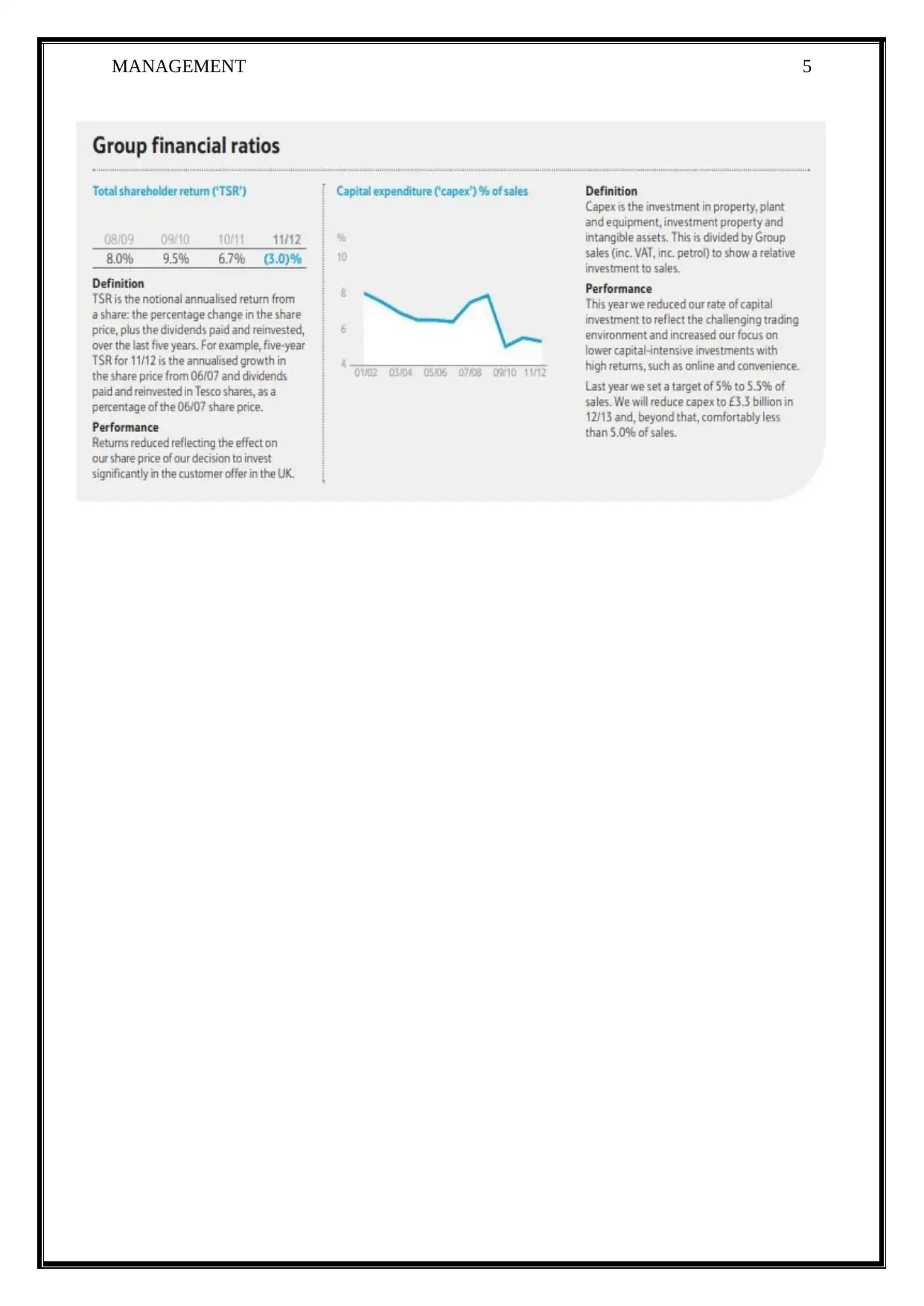
MANAGEMENT 5
⊘ This is a preview!⊘
Do you want full access?
Subscribe today to unlock all pages.

Trusted by 1+ million students worldwide
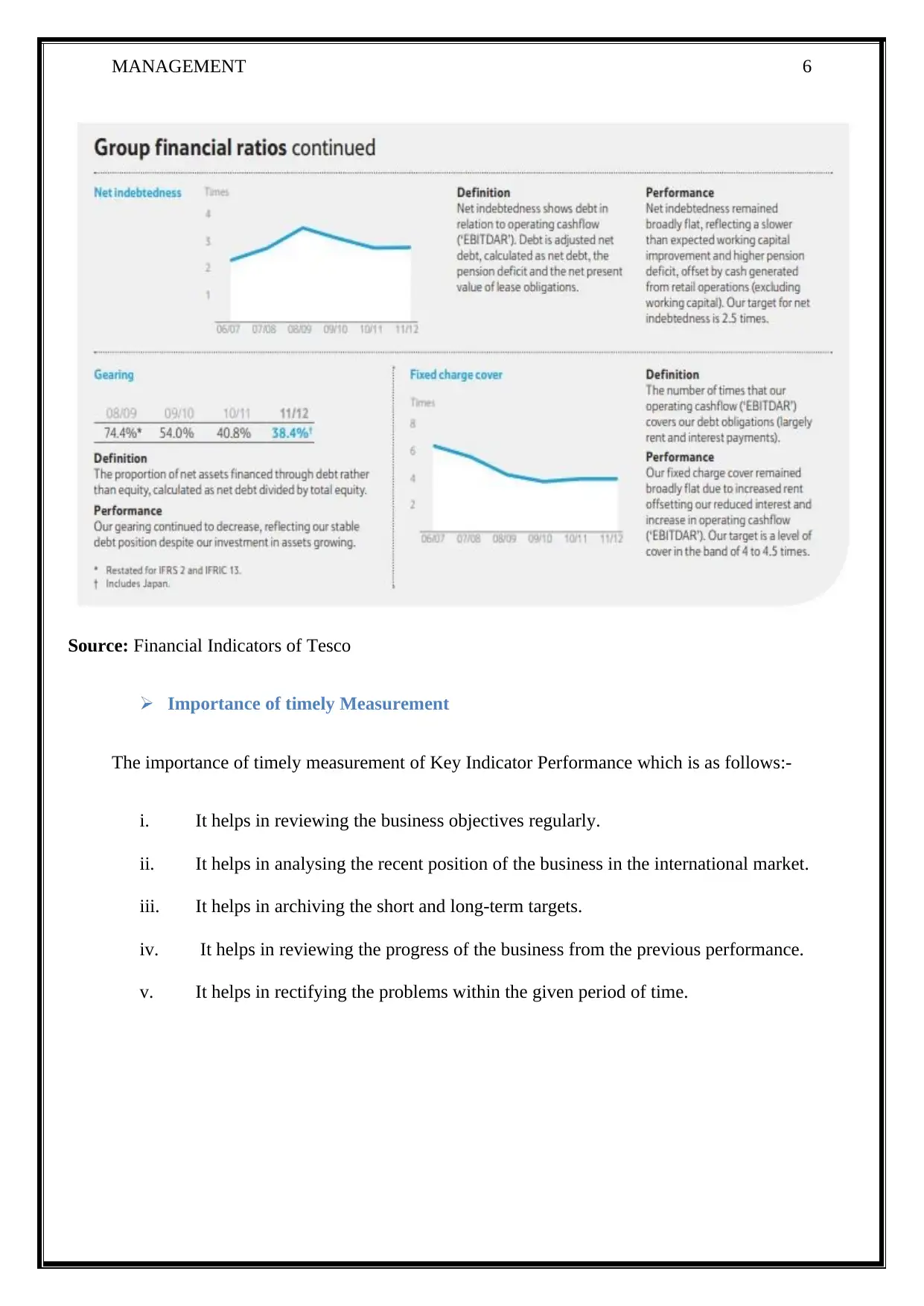
MANAGEMENT 6
Source: Financial Indicators of Tesco
Importance of timely Measurement
The importance of timely measurement of Key Indicator Performance which is as follows:-
i. It helps in reviewing the business objectives regularly.
ii. It helps in analysing the recent position of the business in the international market.
iii. It helps in archiving the short and long-term targets.
iv. It helps in reviewing the progress of the business from the previous performance.
v. It helps in rectifying the problems within the given period of time.
Source: Financial Indicators of Tesco
Importance of timely Measurement
The importance of timely measurement of Key Indicator Performance which is as follows:-
i. It helps in reviewing the business objectives regularly.
ii. It helps in analysing the recent position of the business in the international market.
iii. It helps in archiving the short and long-term targets.
iv. It helps in reviewing the progress of the business from the previous performance.
v. It helps in rectifying the problems within the given period of time.
Paraphrase This Document
Need a fresh take? Get an instant paraphrase of this document with our AI Paraphraser
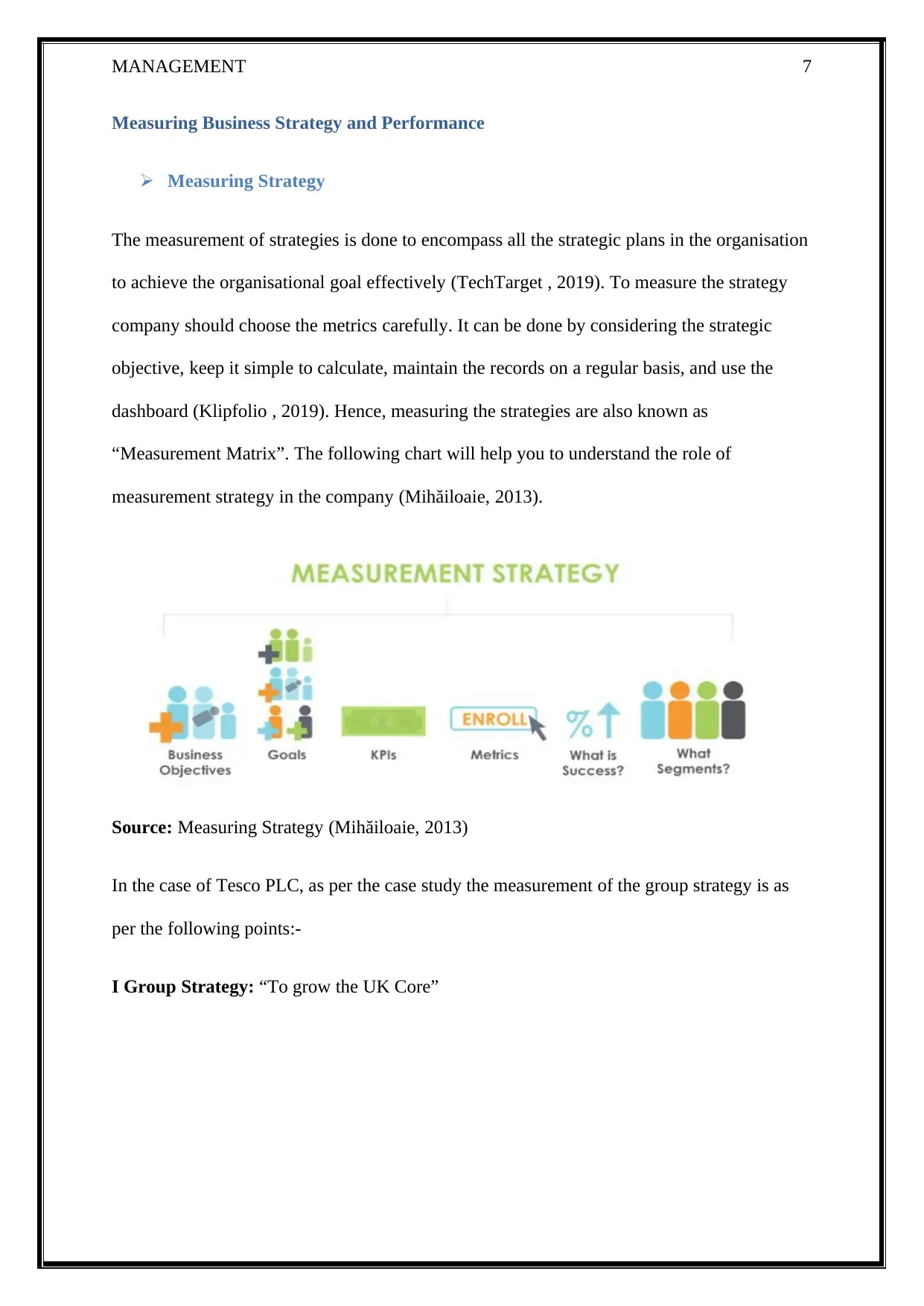
MANAGEMENT 7
Measuring Business Strategy and Performance
Measuring Strategy
The measurement of strategies is done to encompass all the strategic plans in the organisation
to achieve the organisational goal effectively (TechTarget , 2019). To measure the strategy
company should choose the metrics carefully. It can be done by considering the strategic
objective, keep it simple to calculate, maintain the records on a regular basis, and use the
dashboard (Klipfolio , 2019). Hence, measuring the strategies are also known as
“Measurement Matrix”. The following chart will help you to understand the role of
measurement strategy in the company (Mihăiloaie, 2013).
Source: Measuring Strategy (Mihăiloaie, 2013)
In the case of Tesco PLC, as per the case study the measurement of the group strategy is as
per the following points:-
I Group Strategy: “To grow the UK Core”
Measuring Business Strategy and Performance
Measuring Strategy
The measurement of strategies is done to encompass all the strategic plans in the organisation
to achieve the organisational goal effectively (TechTarget , 2019). To measure the strategy
company should choose the metrics carefully. It can be done by considering the strategic
objective, keep it simple to calculate, maintain the records on a regular basis, and use the
dashboard (Klipfolio , 2019). Hence, measuring the strategies are also known as
“Measurement Matrix”. The following chart will help you to understand the role of
measurement strategy in the company (Mihăiloaie, 2013).
Source: Measuring Strategy (Mihăiloaie, 2013)
In the case of Tesco PLC, as per the case study the measurement of the group strategy is as
per the following points:-
I Group Strategy: “To grow the UK Core”

MANAGEMENT 8
Source: “Measurement of Group Strategy”
II Group Strategy: “To be the Outstanding International Retailers” (Tesco PLC , 2012)
Source: “Measurement of Group Strategy” (Tesco PLC , 2012)
III Group Strategy: “To be strong”
Source: “Measurement of Group Strategy”
II Group Strategy: “To be the Outstanding International Retailers” (Tesco PLC , 2012)
Source: “Measurement of Group Strategy” (Tesco PLC , 2012)
III Group Strategy: “To be strong”
⊘ This is a preview!⊘
Do you want full access?
Subscribe today to unlock all pages.

Trusted by 1+ million students worldwide
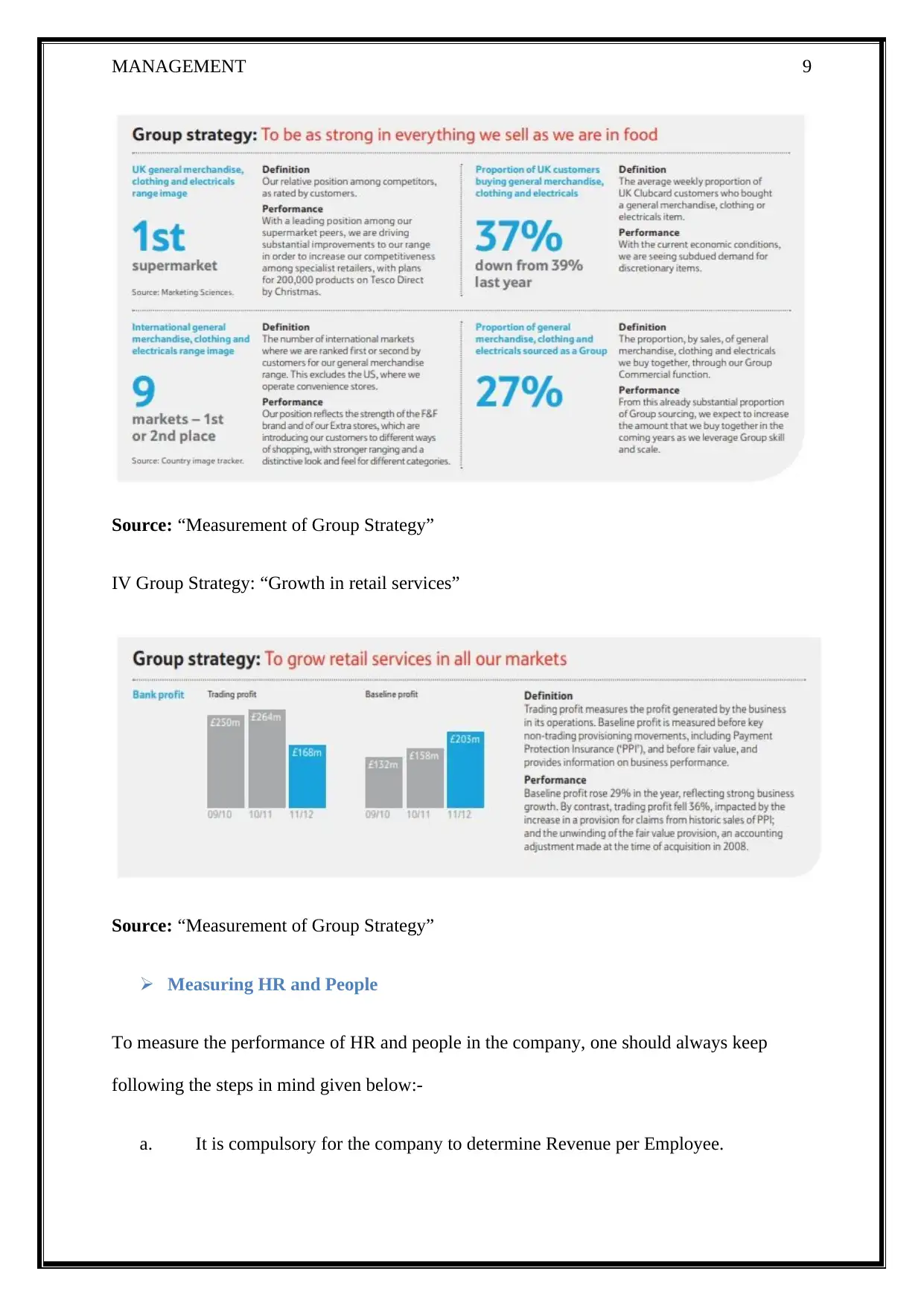
MANAGEMENT 9
Source: “Measurement of Group Strategy”
IV Group Strategy: “Growth in retail services”
Source: “Measurement of Group Strategy”
Measuring HR and People
To measure the performance of HR and people in the company, one should always keep
following the steps in mind given below:-
a. It is compulsory for the company to determine Revenue per Employee.
Source: “Measurement of Group Strategy”
IV Group Strategy: “Growth in retail services”
Source: “Measurement of Group Strategy”
Measuring HR and People
To measure the performance of HR and people in the company, one should always keep
following the steps in mind given below:-
a. It is compulsory for the company to determine Revenue per Employee.
Paraphrase This Document
Need a fresh take? Get an instant paraphrase of this document with our AI Paraphraser
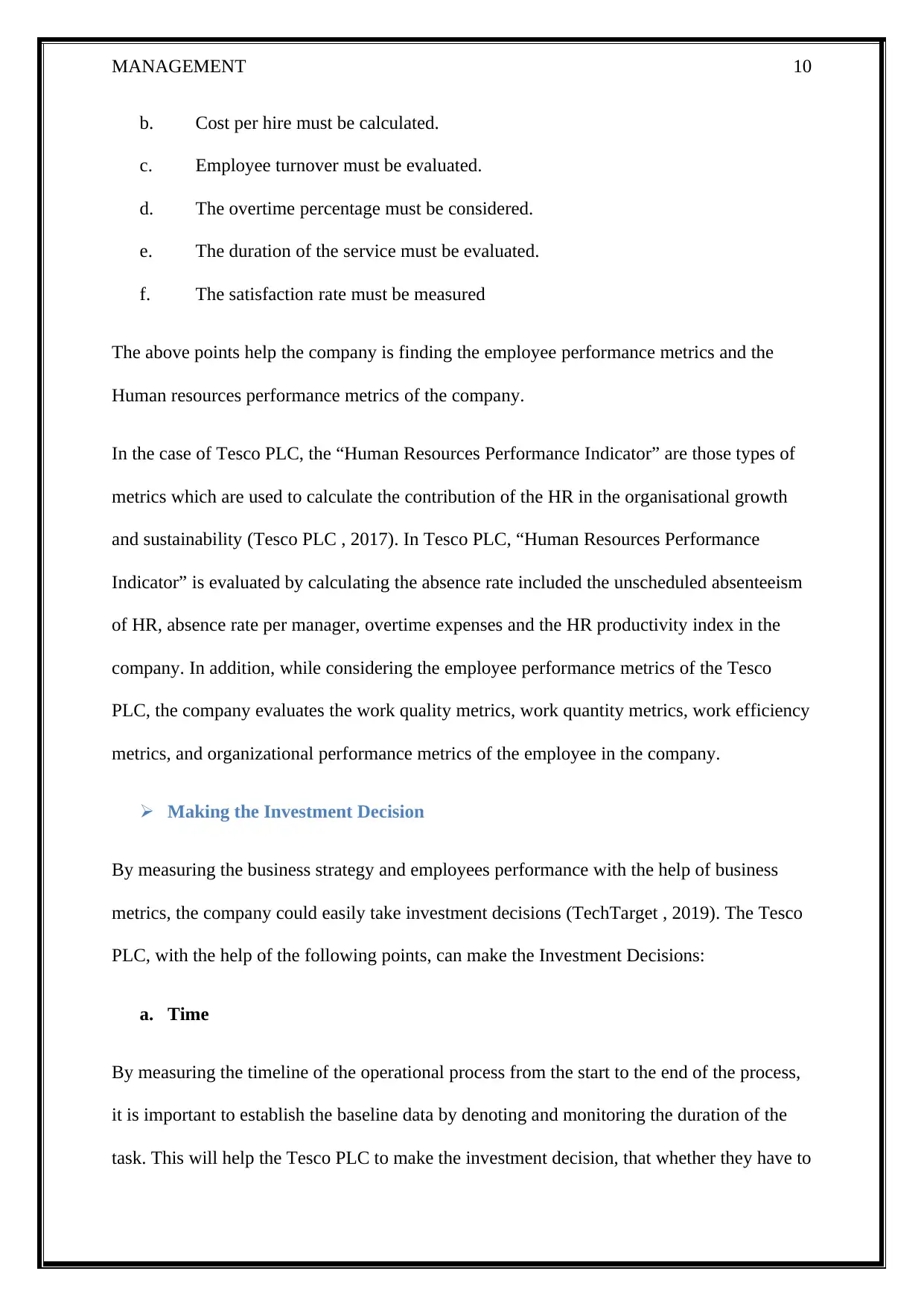
MANAGEMENT 10
b. Cost per hire must be calculated.
c. Employee turnover must be evaluated.
d. The overtime percentage must be considered.
e. The duration of the service must be evaluated.
f. The satisfaction rate must be measured
The above points help the company is finding the employee performance metrics and the
Human resources performance metrics of the company.
In the case of Tesco PLC, the “Human Resources Performance Indicator” are those types of
metrics which are used to calculate the contribution of the HR in the organisational growth
and sustainability (Tesco PLC , 2017). In Tesco PLC, “Human Resources Performance
Indicator” is evaluated by calculating the absence rate included the unscheduled absenteeism
of HR, absence rate per manager, overtime expenses and the HR productivity index in the
company. In addition, while considering the employee performance metrics of the Tesco
PLC, the company evaluates the work quality metrics, work quantity metrics, work efficiency
metrics, and organizational performance metrics of the employee in the company.
Making the Investment Decision
By measuring the business strategy and employees performance with the help of business
metrics, the company could easily take investment decisions (TechTarget , 2019). The Tesco
PLC, with the help of the following points, can make the Investment Decisions:
a. Time
By measuring the timeline of the operational process from the start to the end of the process,
it is important to establish the baseline data by denoting and monitoring the duration of the
task. This will help the Tesco PLC to make the investment decision, that whether they have to
b. Cost per hire must be calculated.
c. Employee turnover must be evaluated.
d. The overtime percentage must be considered.
e. The duration of the service must be evaluated.
f. The satisfaction rate must be measured
The above points help the company is finding the employee performance metrics and the
Human resources performance metrics of the company.
In the case of Tesco PLC, the “Human Resources Performance Indicator” are those types of
metrics which are used to calculate the contribution of the HR in the organisational growth
and sustainability (Tesco PLC , 2017). In Tesco PLC, “Human Resources Performance
Indicator” is evaluated by calculating the absence rate included the unscheduled absenteeism
of HR, absence rate per manager, overtime expenses and the HR productivity index in the
company. In addition, while considering the employee performance metrics of the Tesco
PLC, the company evaluates the work quality metrics, work quantity metrics, work efficiency
metrics, and organizational performance metrics of the employee in the company.
Making the Investment Decision
By measuring the business strategy and employees performance with the help of business
metrics, the company could easily take investment decisions (TechTarget , 2019). The Tesco
PLC, with the help of the following points, can make the Investment Decisions:
a. Time
By measuring the timeline of the operational process from the start to the end of the process,
it is important to establish the baseline data by denoting and monitoring the duration of the
task. This will help the Tesco PLC to make the investment decision, that whether they have to
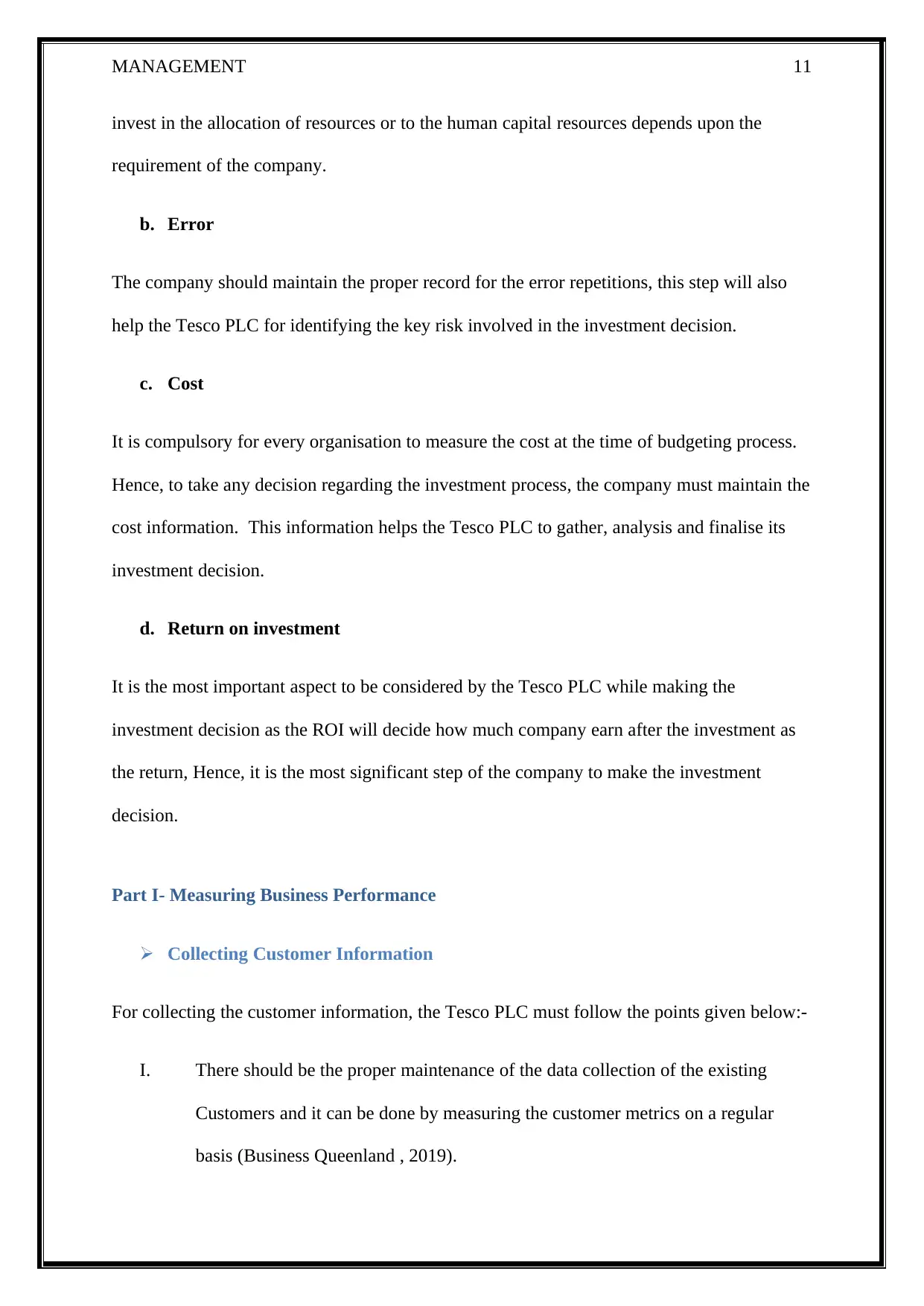
MANAGEMENT 11
invest in the allocation of resources or to the human capital resources depends upon the
requirement of the company.
b. Error
The company should maintain the proper record for the error repetitions, this step will also
help the Tesco PLC for identifying the key risk involved in the investment decision.
c. Cost
It is compulsory for every organisation to measure the cost at the time of budgeting process.
Hence, to take any decision regarding the investment process, the company must maintain the
cost information. This information helps the Tesco PLC to gather, analysis and finalise its
investment decision.
d. Return on investment
It is the most important aspect to be considered by the Tesco PLC while making the
investment decision as the ROI will decide how much company earn after the investment as
the return, Hence, it is the most significant step of the company to make the investment
decision.
Part I- Measuring Business Performance
Collecting Customer Information
For collecting the customer information, the Tesco PLC must follow the points given below:-
I. There should be the proper maintenance of the data collection of the existing
Customers and it can be done by measuring the customer metrics on a regular
basis (Business Queenland , 2019).
invest in the allocation of resources or to the human capital resources depends upon the
requirement of the company.
b. Error
The company should maintain the proper record for the error repetitions, this step will also
help the Tesco PLC for identifying the key risk involved in the investment decision.
c. Cost
It is compulsory for every organisation to measure the cost at the time of budgeting process.
Hence, to take any decision regarding the investment process, the company must maintain the
cost information. This information helps the Tesco PLC to gather, analysis and finalise its
investment decision.
d. Return on investment
It is the most important aspect to be considered by the Tesco PLC while making the
investment decision as the ROI will decide how much company earn after the investment as
the return, Hence, it is the most significant step of the company to make the investment
decision.
Part I- Measuring Business Performance
Collecting Customer Information
For collecting the customer information, the Tesco PLC must follow the points given below:-
I. There should be the proper maintenance of the data collection of the existing
Customers and it can be done by measuring the customer metrics on a regular
basis (Business Queenland , 2019).
⊘ This is a preview!⊘
Do you want full access?
Subscribe today to unlock all pages.

Trusted by 1+ million students worldwide
1 out of 18
Related Documents
Your All-in-One AI-Powered Toolkit for Academic Success.
+13062052269
info@desklib.com
Available 24*7 on WhatsApp / Email
![[object Object]](/_next/static/media/star-bottom.7253800d.svg)
Unlock your academic potential
Copyright © 2020–2025 A2Z Services. All Rights Reserved. Developed and managed by ZUCOL.





